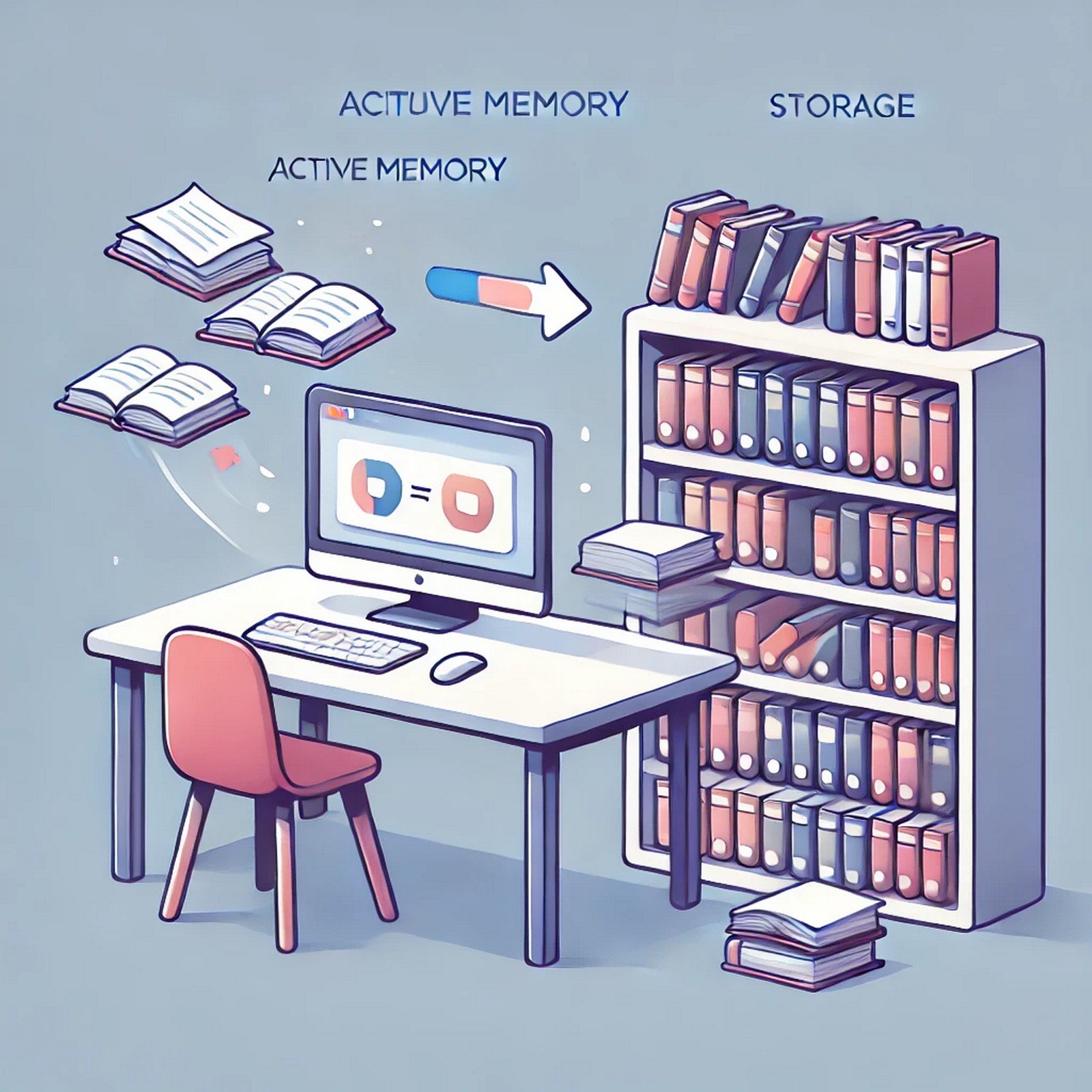Virtual Memory
 (Representational Image | Source: Dall-E)
(Representational Image | Source: Dall-E)
Quick Navigation:
- Virtual Memory Definition
- Virtual Memory Explained Easy
- Virtual Memory Origin
- Virtual Memory Etymology
- Virtual Memory Usage Trends
- Virtual Memory Usage
- Virtual Memory Examples in Context
- Virtual Memory FAQ
- Virtual Memory Related Words
Virtual Memory Definition
Virtual memory is a computer system technique that enables the execution of programs larger than the physical memory by creating an illusion of a large, continuous memory space. It works by using a combination of RAM and storage (like a hard disk) to temporarily transfer data that isn’t actively being used. This mechanism ensures that computers can run multiple applications simultaneously without running out of physical memory. Key components include paging, segmentation, and memory swapping.
Virtual Memory Explained Easy
Imagine you have a small desk but a lot of books to read. You can only place a few books on the desk at a time, while the rest are stored on a nearby shelf. When you need a different book, you swap one on your desk with one from the shelf. Virtual memory is like that desk—it allows your computer to handle more tasks than the physical memory (RAM) can hold by swapping data in and out of storage as needed.
Virtual Memory Origin
The concept of virtual memory was first introduced in the 1950s and 1960s to manage limited memory resources in early computers. The Ferranti Atlas, developed in 1962, was one of the first computers to implement virtual memory successfully.
Virtual Memory Etymology
The term "virtual memory" comes from "virtual," meaning simulated or not physically present, and "memory," referring to data storage space on a computer.
Virtual Memory Usage Trends
Virtual memory has evolved significantly with advances in operating systems and hardware. Modern operating systems like Windows, macOS, and Linux rely on virtual memory to enhance multitasking capabilities and manage memory-hungry applications like video editing software and games. With the rise of solid-state drives (SSDs), virtual memory performance has also seen substantial improvements.
Virtual Memory Usage
- Formal/Technical Tagging:
- Operating Systems
- Computer Architecture
- Memory Management
- Typical Collocations:
- "virtual memory management"
- "paging file"
- "virtual memory allocation"
- "swap space utilization"
Virtual Memory Examples in Context
- When you open many applications at once, your computer uses virtual memory to avoid crashing.
- Virtual memory is critical for video editing software, where project files often exceed the available RAM.
- Gaming on modern PCs requires virtual memory to manage large graphics data efficiently.
Virtual Memory FAQ
- What is virtual memory?
Virtual memory is a computer memory management technique that uses storage as an extension of RAM. - How does virtual memory work?
It swaps data between RAM and storage to create the illusion of more memory. - Why is virtual memory important?
It prevents system crashes by managing memory overflow when RAM is full. - What are the common uses of virtual memory?
Running multiple programs, video editing, and gaming. - How do you configure virtual memory?
Most operating systems manage it automatically, but users can adjust settings in system preferences. - What is paging in virtual memory?
Paging is a method where data is divided into fixed-size blocks called pages and transferred between RAM and storage. - What is a swap file?
It’s a space on the hard drive used for storing pages swapped out of RAM. - Can virtual memory slow down my computer?
Yes, especially if your system uses a slow hard drive for virtual memory. - What happens if virtual memory is full?
Your computer may crash or slow down significantly. - What is the difference between RAM and virtual memory?
RAM is physical memory, while virtual memory is an extension that uses storage to simulate more RAM.
Virtual Memory Related Words
- Categories/Topics:
- Operating Systems
- Memory Management
- Computer Architecture
Did you know?
Virtual memory played a crucial role in the development of modern computing. Without it, multitasking and running large applications on personal computers would have been impossible. The Ferranti Atlas was the first computer to implement virtual memory in 1962.
PicDictionary.com is an online dictionary in pictures. If you have questions or suggestions, please reach out to us on WhatsApp or Twitter.Authors | Arjun Vishnu | @ArjunAndVishnu

I am Vishnu. I like AI, Linux, Single Board Computers, and Cloud Computing. I create the web & video content, and I also write for popular websites.
My younger brother, Arjun handles image & video editing. Together, we run a YouTube Channel that's focused on reviewing gadgets and explaining technology.



Comments powered by CComment